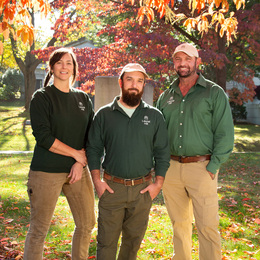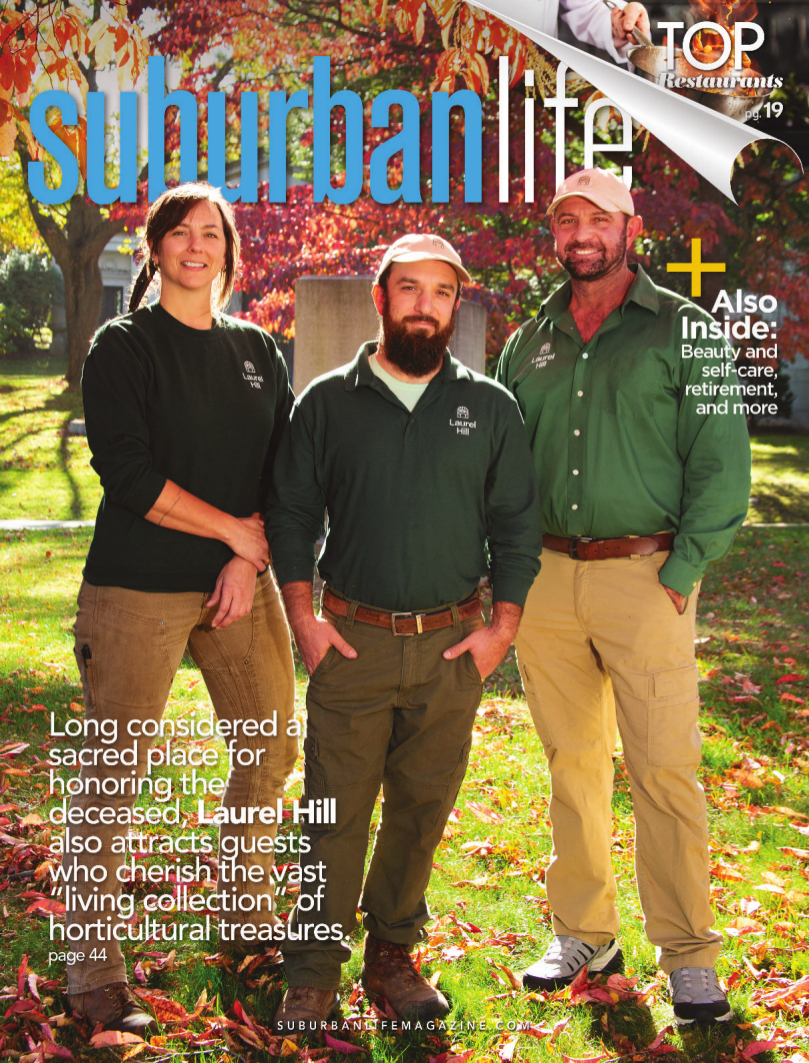Long considered a sacred place for honoring the deceased, Laurel Hill also attracts guests who cherish the vast “living collection” of horticultural treasures.
People tend to associate cemeteries with death and loss, but Laurel Hill aims to help visitors “appreciate the beauty of the living world in a place built to honor the dead.” Since its founding in 1836, Laurel Hill has curated the landscape with an ever-growing collection of trees, shrubs, and display gardens abloom with annuals and perennials.
Laurel Hill’s two campuses—Laurel Hill East in Philadelphia’s Paradise neighborhood, and Laurel Hill West in Bala Cynwyd—include 6,000 specimen trees and shrubs, representing more than 700 unique species and cultivars, including several state-champion trees. Laurel Hill’s gardens, groves, and meadows are integral to the cemeteries’ identity, according to President Nancy A. Goldenberg.
“Horticulture is at the root of Laurel Hill, an intended pun,” Goldenberg says. “John Jay Smith, our founder, knew quite a lot about horticulture. He laid out the cemetery grounds, and he understood even then what today we might refer to as ‘Nature Rx’—that spending time in nature is good for our overall health and wellbeing. He located the cemetery on the bluffs overlooking the Schuylkill River so people could get away from the industrialization of the city and enjoy the fresh air and natural beauty.”
The joy, peace, and profundity that comes from spending time outdoors is what attracted Aaron Greenberg to a career in horticulture. Today, as Laurel Hill’s arboretum manager, Greenberg oversees every aspect of horticulture on the 265-acre landscape.
“It’s a ton of work, because every layer of living plant life has its own workload,” he says. “We start with the soil, and we now have an area where we recycle all the soil, making our own compost and mulch. We think about the soil with everything we do. We’re also cutting the grass five to six days a week, intensively managing the herbaceous garden areas, and managing the gardens on the individual burial plots. We’re also an accredited arboretum, so the curation, labeling, and mapping—that’s all part of the job as well.”
Managing a vast “living collection” certainly has its share of challenges, including those imposed by climate change. While the collection has been thoughtfully tended—to provide habitat for native species, for example—the arboretum staff also has to contend with some surprises.
“Over the last 150 years, a lot of people have planted shrubs around their individual burial lots, either with or without permission, so we have to maintain those, too,” says Greenberg. “We manage those lots in a specific way.”
Goldenberg suggests visitors play a vital role in maintaining Laurel Hill’s living collection.
“We have people who walk their dogs in the cemetery every day, and they care about the cemeteries,” she says. “They will come to us and say, ‘There’s a branch down’ or something else has happened; they’re very protective, almost like it’s their backyard. We have 265 acres, so it’s comforting to know we have all these eyes and ears. It’s what makes Laurel Hill so cherished.”
Laurel Hill has earned the distinction of being a Level II-accredited arboretum, which means, among other things, it has a minimum number of 100 species, varieties, or cultivars of trees or woody plants; one or more arboretum employees who have job responsibilities that specifically include management or operation of the arboretum; and enhanced horticulture-specific educational and public programming.
In regard to education and programming, Laurel Hill offers public and private tours, as well as year-round programming built specifically around horticulture, all designed to inform and educate the public. Greenberg leads tours of the tree collection throughout the seasons—fall foliage, winter walk, spring arbor, and summer shade. In addition, Laurel Hill is in its third year of participating in the TreeKeeper program, which enables guests to learn about Laurel Hill’s collection by way of an app for smartphones and laptops.
Laurel Hill also works closely with local garden clubs, public gardens, and other groups. Gregg Tepper, senior horticulturist for Laurel Hill, cites a recent partnership with Philadelphia’s Weitzman National Museum of Jewish History to celebrate Tu BiShvat, a wintertime holiday tied to ecological awareness. Tepper suggests Laurel Hill will continue to expand programming to make use of its abundant natural resources—including Nature’s Sanctuary, a green burial area at Laurel Hill West—for a specific goal: to help those who are grieving after the loss of a loved one.
“Therapeutic horticulture has been one of the keys to our success,” Tepper says. “In October, we did a fall family planting day for those who have loved ones buried at Laurel Hill. We have different therapy programs throughout the year, and at each one people say the same thing: ‘We want more of this.’”
Laurel Hill’s Legacy Tree Program provides another distinctive way to memorialize loved ones who have passed. Participants in the program can choose to either adopt a distinctive tree on the grounds or work with the arboretum staff to plant a species of tree that best suits the person to whom they want to pay tribute.
Public engagement also happens in more informal ways. Greenberg points to the Kelly Drive Hillside Project.
“For the steep hillside overlooking Kelly Drive, we’re converting [the vegetation] from invasive species to 100 percent native meadow species,” he says. “We’re doing that for a number of reasons, but the main point is that the public sees us being committed to ecological stewardship. We’re converting this ecosystem into something that will be beneficial for local pollinators and wildlife. It’s about civic value, showing that we’re serious about improving the overall environment of communities in a holistic way.”
Laurel Hill maintains a full-time horticulture team of three people, though the numbers swell in the summer months thanks to seasonal employees and participants in a robust internship program. Tepper supervises and mentors the interns, who do everything from pulling weeds and overseeing small areas of the grounds to acting as “ambassadors” who help to enhance the guest experience.
Greenberg recalls his start at Morris Arboretum in Chestnut Hill as “a life-changing experience,” so he knows how important it is for someone who is interested in a horticulture career to have a good first experience. Laurel Hill’s role in shaping the next generation of horticulturists underscores the reverence it pays to the natural world. It also adds to Laurel Hill’s reputation as a world-class arboretum in a truly distinctive setting.
“Horticulture is part of our mission,” Greenberg says. “We have to look toward the past and honor the intent of our founder, who understood the power of spending time in nature. At the same time, we have to honor the present and the future by maintaining the landscape and being good stewards of the environment. We want to make sure it’s here to be enjoyed for generations to come.”
Laurel Hill
laurelhillphl.com
Laurel Hill East
3822 Ridge Ave.
Philadelphia, PA 19132
(215) 228-8200
Laurel Hill West and Laurel Hill Funeral Home
225 Belmont Ave.
Bala Cynwyd, PA 19004
(610) 668-9900
Photo by Alison Dunlap
Published (and copyrighted) in Suburban Life, October 2023.




